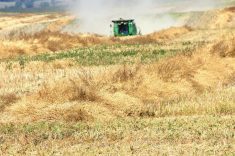A herd of wild boars continues to roam the backwoods of one Manitoba municipality, making it harder for provincial government departments to ignore the problem.
“People would certainly like to get rid of these animals. They have over-wintered a second year now and the sows are likely pregnant and will be giving birth again soon,” said Ed Tallieu, agriculture representative near Beausejour, Man.
But it won’t be easy.
Caught in a web of cross-jurisdiction and legal semantics, the boars, now truly wild animals, may enjoy another summer of freedom.
Read Also

Alberta researcher helps unlock the economics of farming
Lethbridge Polytechnic researcher helping agriculture producers with decision-making tools in economic feasibility
“It’s not just like going out and rounding up some cattle,” Tallieu said, describing wild boar as smarter, faster, unpredictable and dangerously people smart.
“It’s like guerilla warfare and they know the territory.”
Last summer, one Beausejour-area family complained the animals were rooting up their garden, attacking pets and scaring their children. They brought a complaint to the Farm Practices Protection Board.
The matter is in limbo after the owner sold the remainder of his herd.
The problem hasn’t been confined to Beausejour. There were reports that eight animals escaped from a farm near Stonewall two weeks ago, and last month a Winnipeg police officer shot two wild boars near Transcona in the city’s east side.
Tallieu said the animals had been de-tusked and were kept as pets before they escaped.
“I understand the people were quite upset about it,” Tallieu said.
“Some people may think it is wrong to irradicate them but they are the wrong animal in the wrong place.”
The animals, which ignore people whenever possible, might view an attempt to shoo them out of a garden as an attack and fight back, especially a sow and her newborns.
“You don’t want to be caught where you’ve come across a boar and put him in that position,” Tallieu said.
“They would come after you and hurt you quite severely … with their tusks, which are very sharp.”
Authorities are struggling with how to classify the animals – as domestic animals that have escaped and turned wild, or wild animals that were wrongly domesticated.
Tallieu said it’s a difficult question that can no longer be ignored.
“They were a domestic animal, which are against the law to shoot, but are they now wild? And how many years do they have to be escaped to be considered wild?”
The department of natural resources, with jurisdiction over wild animals, says it isn’t responsible because the animals were originally kept as a domestic herd the same as cattle.
Manitoba Agriculture, which handles livestock, says if they are domestic animals, they are the responsibility of the owner.
The problem is there’s no way to determine who owns the animals or how many were born in the wild.
“When you ask the agencies to deal with them in an official capacity, they are encumbered with the legal end of it and the wording,” Tallieu said. “And the fear is you now have to take responsibility for a problem you can’t really control.”
The municipality has discussed outlawing wild boar farms in the area, but Tallieu said that isn’t the solution.
“You don’t like to enact municipal legislation too quickly if it’s an isolated incident.”
As it stands now, Tallieu said Manitoba Agriculture and Natural Resources are talking about working together on the problem to trap the boars and remove them from the area or shoot them.














